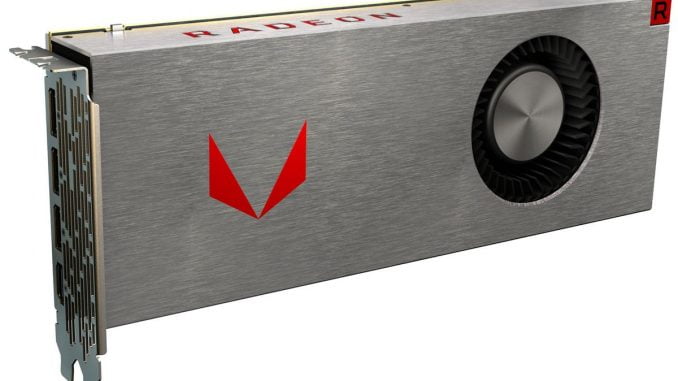
/cdn.vox-cdn.com/uploads/chorus_image/image/55972009/amdvega64.0.jpg)
AMD is finally unveiling its Radeon RX Vega family of GPUs today, designed to compete with Nvidia at the high end of gaming PCs. Its been years since AMD has truly competed at the top, and the last new flagship card, the Fury X, was released back in 2015. AMD’s Fury X was a reasonable competitor with its unique high-bandwidth memory (HBM), but Nvidia toppled it by releasing the powerful GTX 980 Ti. More than two years later, there’s now a gap in the market that’s been dominated by a standard combination of an Intel Core i7 processor and Nvidia GTX 1080 grahics card. AMD wants to attack that gap on August 14th.
We’ve seen plenty of teases about the Vega architecture over the past year, but AMD is now revealing pricing and release dates today for its high-end cards. AMD is launching three cards, with the top being liquid cooled. The standalone Radeon RX Vega 56 (with 56 compute units) will debut on August 14th priced at $399, alongside the $499 Vega 64 air cooled card. AMD is also launching Radeon Packs that bundle games and discounts for hardware that will match the GPU, and you’ll need to opt for one of these if you want a liquid cooled version of the Vega 64.
There are three packs available, and each bundles Wolfenstein II: The New Colossus and Prey. Radeon Packs also include a $200 discount on Samsung’s 34-inch curved ultrawide FreeSync monitor, and a $100 discount on some Ryzen 7 1800X processor and 370X motherboard combos.
- Radeon Red Pack – Featuring the Radeon RX Vega 56, an air-cooled card priced at $499.
- Radeon Black Pack – Featuring the Radeon RX Vega 64, an air-cooled card priced at $599.
- Radeon Aqua Pack – Featuring the Radeon RX Vega 64 Liquid Cooled Edition priced at $699.
AMD is promising more than 200 percent of the throughput-per-clock over previous Radeon GPU architectures, alongside a new version of its high-bandwidth memory. HBM2 doubles the bandwidth per pin, and is designed to stack vertically around the GPU to transfer more data at a time than traditional GDDR5 memory. AMD is promising 13.7 teraflops of performance out of the top RX Vega 64 card, but the company isn’t providing many other hints at what that means in terms of pure frames per second performance in games.
/cdn.vox-cdn.com/uploads/chorus_asset/file/8962103/raja_koduri_and_scott_herkelman___radeon_rx_vega_33_575px.png)
AMD has released some vague performance slides for the Vega 64, focusing on the minimum framerates in titles like Battlefield 1, Gears of War, and Forza. Anandtech has analyzed these promises further, but as the cards don’t actually launch today we’ll have to wait a couple of weeks to see true benchmarks. It looks, on paper at least, like the Vega 64 will be competing with Nvidia’s GTX 1080.
That’s an encouraging sign after the Vega Frontier Edition appeared in June and Nvidia’s GTX 1080 still easily beat it. AMD said at the time that the card was primarily designed for 3D content creation rather than gaming, but it still made gamers nervous after the long wait for the Vega 64.
AMD has been poking at the established Intel and Nvidia combination for high-end gaming PCs, and the company’s 16-core Threadripper processors even prompted Intel to respond with its own 18-core Core i9 chip. If AMD has managed to compete well with Nvidia’s established GTX 1080 or even the 1080 Ti then it won’t have to wait long for Nvidia to respond. Nvidia is expected to launch its Volta line of GPUs in early 2018 with its own version of AMD’s high-bandwidth memory.
Source:-.theverge
